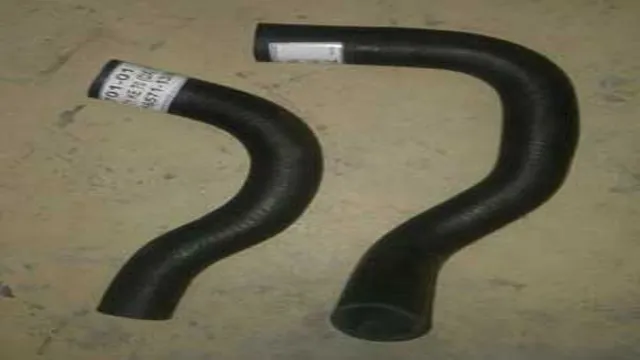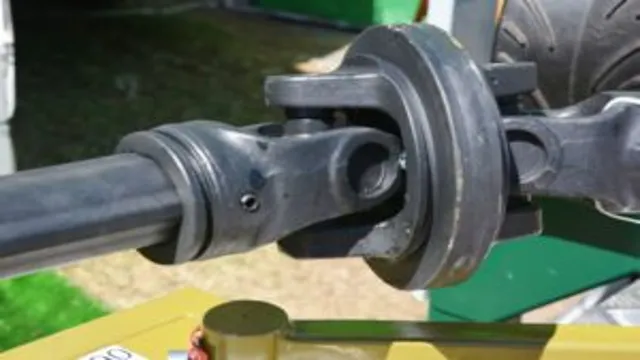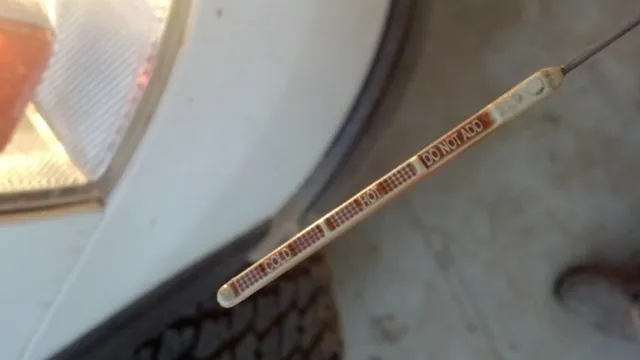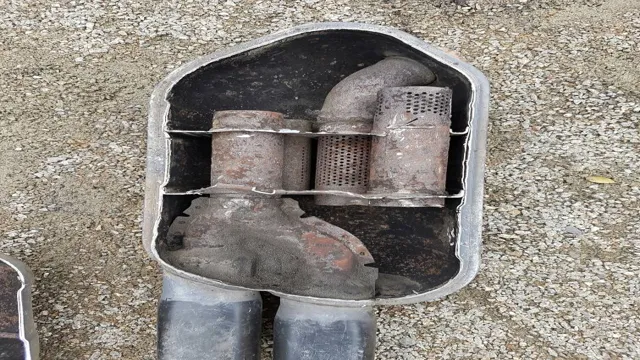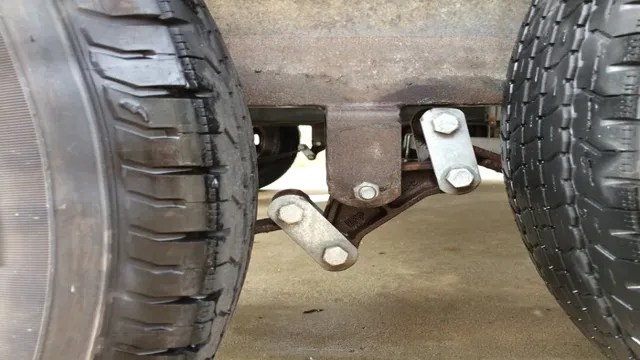Water in Engine Oil? Here’s How to Fix it Like a Pro!
Are you facing issues with water in your engine oil? The sight of water in your engine oil can be a daunting one, and understandably so. This problem can lead to severe damages if not dealt with adequately. The presence of water in the engine oil alters its lubricating properties, making it difficult for oil to protect the engine’s moving parts from wear and tear.
If you don’t act fast, your engine can get severely damaged, leading to costly repairs. But don’t worry- fixing water in engine oil doesn’t have to be a daunting task. In this step-by-step guide, we’ll equip you with all the necessary knowledge to tackle this problem.
We’ll take you through the various reasons for water in engine oil, the signs to look out for, and most importantly, the solutions to fix it. Whether your engine has been exposed to flooding, a blown head gasket, or just condensation issues, we’ve got you covered. We’ll provide you with actionable steps that will help you get your engine up and running in no time.
So, sit tight and get ready to learn how to fix water in your engine oil like a pro!
Identifying the Problem
If you notice water in your engine oil, there are several possible causes. One of the most common causes is a blown head gasket, which can result in coolant leaking into your oil. This problem can also lead to overheating, loss of coolant, and engine damage if left unrepaired.
Another possible cause is a cracked engine block or cylinder head, which can allow coolant to leak into the oil. Additionally, condensation can form in the oil if your engine isn’t being used regularly, especially in colder climates. To fix this issue, you’ll need to identify the root cause of the problem and make the necessary repairs.
In some cases, this may mean replacing the head gasket or engine block, while in others it may mean flushing the engine and changing the oil. Whatever the solution, it’s important to address this issue promptly to prevent further damage to your engine. If unsure, it’s always best to consult with a mechanic or automotive expert for guidance.
Visual Inspection
Visual inspections are an essential part of preventative maintenance for any machinery, as they allow for the identification of potential issues before they become larger problems. During a visual inspection, it’s important to pay attention to all details, no matter how seemingly small. Any changes to the machine’s appearance, such as rust or wear and tear, should be noted.
Additionally, any unusual noise, vibration, or smells should be carefully observed. By identifying and addressing these problems early on, it’s possible to avoid costly repairs down the line. The key to a successful visual inspection is to be diligent and thorough, taking the time to carefully examine every aspect of the machine.
By doing so, you can ensure that your equipment stays in top working order for years to come.
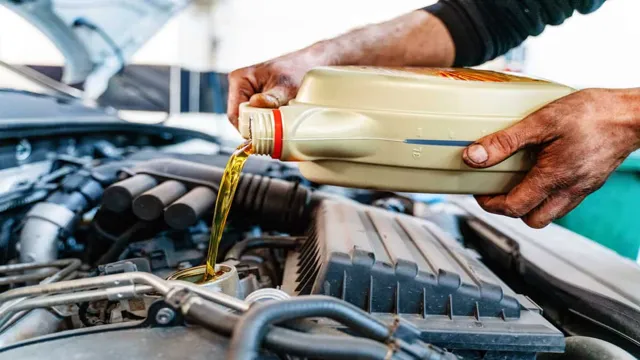
Oil Analysis
Oil analysis is an essential process in identifying potential problems in machinery and equipment. By analyzing the oil’s properties, we can identify if there is enough lubrication, if there are contaminants, and if there is excessive wear within the system. The analysis process may include assessing the oil’s viscosity, acidity, and any metallic debris within the oil sample, which can provide an indication of the wearing of machinery’s equipment.
By identifying these potential issues early, we can avoid costly repairs and machine breakdowns, which can be a significant setback for a business. Investing in regular oil analysis can benefit companies in the long run, as it guarantees equipment functionality and optimal performance. Therefore, it is crucial to have a schedule in place for regular oil analysis to help prevent significant issues before they occur.
Common Causes of Water in Engine Oil
If you have ever noticed water in your engine oil, you will know it can be a major concern. But how does this happen and what can you do to fix it? There are several common causes of water mixing with engine oil such as a damaged head gasket, cracked engine block, or a corroded cylinder head. Water can also make its way into the oil if the car has been operated in cold weather or from a damaged oil cooler.
If you notice water in your engine oil, the first step is to diagnose the problem and determine the cause. You may need to take your car to a professional mechanic to identify the issue causing the water to enter the oil system. Depending on the root of the problem, the solution can range from a simple repair to a complete engine rebuild.
In any case, it’s important to not ignore water in the engine oil as it can cause severe damage to your car’s engine.
Head Gasket
If you find water in your engine oil, it can cause serious damage to your car’s engine. One of the most common causes of water in the engine oil is a blown or damaged head gasket. The head gasket sits between the engine block and the cylinder head and helps to seal the combustion chambers.
When the head gasket fails, coolant can leak into the oil passages, causing the oil to become diluted with water. This can cause damage to bearings and other engine components, leading to engine failure if not addressed promptly. Other common causes of water in the engine oil include a cracked engine block or cylinder head, damaged engine seals, or a damaged oil cooler.
It’s important to have your car inspected by a professional mechanic if you notice any signs of water in the engine oil, such as a milky or frothy appearance or a low oil level. Ignoring the problem can lead to costly repairs or engine replacement, so it’s best to address it as soon as possible. In summary, water in the engine oil can indicate a serious problem with your car’s engine.
A blown head gasket is one of the most common causes, but there are other possible culprits as well. If you notice signs of water in the engine oil, don’t wait to have it checked out-early detection can save you money and prevent further damage to your car’s engine.
Cracked Engine Block
When water finds its way into a vehicle’s engine oil, it can create a host of problems. One of the most severe outcomes is a cracked engine block, which can be due to several different causes. One common cause is a failed head gasket, which allows coolant to leak into the oil passages.
Another possibility is a rusted or corroded engine block, which can allow water to seep in. Additionally, a cracked cylinder head or engine block itself can also cause coolant to mix with the oil. Ultimately, water in the engine oil can lead to increased wear and tear, decreased engine performance, and eventually, a completely unusable engine.
Keeping an eye on vehicle maintenance and catching any issues early on can help prevent this costly and frustrating scenario from happening.
Internal Corrosion
Internal Corrosion Water in engine oil is a common problem that many people face. It can be caused by internal corrosion, which is the gradual wearing away of metal parts due to chemical reactions. One of the most common causes of internal corrosion is a coolant leak.
When the coolant leaks into the engine oil, it can cause damage to the engine and lead to the formation of sludge. Another major cause of water in engine oil is condensation. When the engine cools down, moisture can accumulate and mix with the oil, leading to a milky appearance.
Another factor that can contribute to internal corrosion and water in engine oil is the presence of acids. These acids can be formed from the combustion process or from contaminants in the fuel and oil. To prevent or minimize internal corrosion, it is important to maintain a regular maintenance schedule and replace any damaged or worn parts.
Additionally, using high-quality oil and fuel can help reduce the buildup of acids and other contaminants that can contribute to corrosion. So, keep a close eye on the levels and appearance of your engine oil to catch any potential problems early on.
Options for Fixing the Problem
If you’ve discovered water in your engine oil, there are a few options for getting it fixed. The first step is to determine the root cause of the issue, which could be anything from a blown head gasket to a cracked engine block. Once you’ve identified the problem, you can begin to explore potential solutions.
In some cases, the best course of action may be a complete engine replacement, which can be expensive but will ensure that the issue is fully resolved. Alternatively, you may be able to perform a repair by replacing specific parts, such as the head gasket or water pump. Ultimately, the best solution will depend on the severity of the problem and the cost of each potential fix.
If you’re unsure how to proceed, it’s always best to consult with a trusted mechanic who can provide expert advice based on your specific situation. Remember to act quickly, as leaving water in your engine oil for too long can lead to costly and potentially irreversible damage.
Replacing the Head Gasket
When it comes to a damaged head gasket on your vehicle, you might be wondering what your options are for fixing the problem. There are a few approaches that you can consider, depending on the severity of the damage and your budget. The first option is to replace the head gasket entirely.
This involves removing the engine cylinder head and replacing the damaged gasket with a new one. While this can be a costly repair, it can be a worthwhile investment in the longevity of your vehicle. However, if the damage is less severe, you might consider using a sealant as a temporary fix.
This is a liquid that you pour into the radiator or cooling system, and it helps to seal any small leaks in the head gasket. While this isn’t a permanent solution, it can be a cost-effective way to buy some time before you need to invest in a full replacement. Ultimately, the best option for you will depend on your specific situation, so it’s worth consulting with a professional mechanic to determine the best course of action.
Repairing the Cracked Engine Block
If you have a cracked engine block, you need to address the issue as soon as possible. Fortunately, there are several options for fixing the problem. One option is to replace the entire engine block, but this can be expensive and time-consuming.
Another option is to repair the crack using epoxy. This method involves cleaning the area around the crack and applying the epoxy using a brush or syringe. While this may be a more cost-effective solution, it’s important to note that it may not be a permanent fix and may only buy you some time before further repairs are needed.
Ultimately, the best option for repairing a cracked engine block will depend on the extent of the damage and your budget. It’s always best to consult with a professional mechanic to determine the best course of action to get your vehicle back on the road.
Flushing the Engine Oil System
When you start to experience issues with your engine oil system, one of the fixes you may consider is flushing the system. This involves draining all the old oil and refilling it with fresh oil. There are a few different options when it comes to flushing your engine oil system, including using a flushing oil additive or physically cleaning the system.
If you choose to use an additive, be sure to read the instructions carefully to ensure you are using the right amount. Alternatively, you can opt for a physical cleaning which involves manually removing any sludge or debris that may be clogging your engine. Whatever option you choose, always make sure to use high quality oil to keep your engine running smoothly.
Remember, taking care of your engine oil system is important to maintaining the health and longevity of your vehicle.
Preventing Water in Engine Oil
If you’ve found water in your engine oil, don’t panic. This can be a common issue, but it does require immediate attention to prevent damage to your engine. First, identify the source of the water.
It could be a cracked cylinder head, a warped engine block, or even something as simple as a faulty gasket or seal. Once you’ve identified the source, ensure that it’s fixed before proceeding with the next step. Next, drain the oil and replace it with fresh oil.
This will help flush out any remaining water in the system. It’s important to also replace the oil filter, as it may have water trapped inside. Additionally, check the coolant system to ensure there are no leaks or issues that may have caused the water in the engine oil.
By taking these steps and addressing the root cause of the water in the engine oil, you can prevent further damage and keep your engine running smoothly.
Regular Oil Changes
Regular oil changes are an important part of vehicle maintenance that can help prevent water from getting into the engine oil. Water in engine oil can cause serious damage to the engine, leading to costly repairs. During the combustion process, water vapor can form inside the engine’s crankcase, which needs to be removed through regular oil changes.
The process of changing the oil involves draining the old, contaminated oil from the engine and replacing it with new, clean oil. This not only removes the water from the engine but also helps to lubricate the internal components, ensuring they are working efficiently. By getting your oil changed at regular intervals, you can prevent water from seeping into the engine and causing unnecessary damage.
So, make sure to prioritize regular oil changes to keep your engine in top condition and avoid costly repairs down the road.
Proper Maintenance Techniques
Preventing water in engine oil is essential for maintaining the longevity and efficiency of your car’s engine. One of the most common causes of water in the engine oil is a blown head gasket. A blown head gasket can allow coolant to enter your engine’s oil passages, leading to the formation of a milky sludge.
To avoid this, make sure to regularly check your engine’s oil levels and inspect for any signs of milky or frothy oil. You should also keep an eye on your car’s coolant levels and ensure that your radiator and hoses are in good condition. Additionally, regular oil changes and using high-quality oil are vital for preventing contaminants from building up in your engine.
By following these simple maintenance techniques, you can help prevent water in engine oil and keep your car’s engine running smoothly.
Conclusion
In conclusion, fixing water in your engine oil can be a wet and wild ride, but it’s not impossible. Whether you choose to replace your head gasket, flush your system or simply park your car on higher ground during monsoon season, the most important thing is to act quickly. Remember, oil and water may not mix, but a little know-how and some elbow grease can help you keep your engine running smoothly for miles to come.
So, stay calm, get your toolkit and “oil” be back on the road in no time.
FAQs
What causes water to get into the engine oil?
Water can enter the engine oil system due to a variety of reasons such as a damaged cylinder head gasket, cracked engine block, damaged or worn out seals, or even condensation in the engine.
What are the signs of water in engine oil?
Some of the common signs of water in the engine oil include the sight of milky or frothy engine oil, low oil pressure, overheating or constantly having to refill engine oil.
Can water in engine oil cause damage to the engine?
Yes, water in the engine oil can cause significant damage to the engine. Water does not lubricate the engine effectively and can cause damage to the engine bearing, camshaft, crankshaft and other parts.
How do you fix water in engine oil?
To fix water in the engine oil, one must first identify the source of the water contamination. If it is due to a damaged gasket, seal or crack, then these parts must be replaced. It is also recommended to perform an oil change and flush the system with a specialized engine oil flush fluid.


